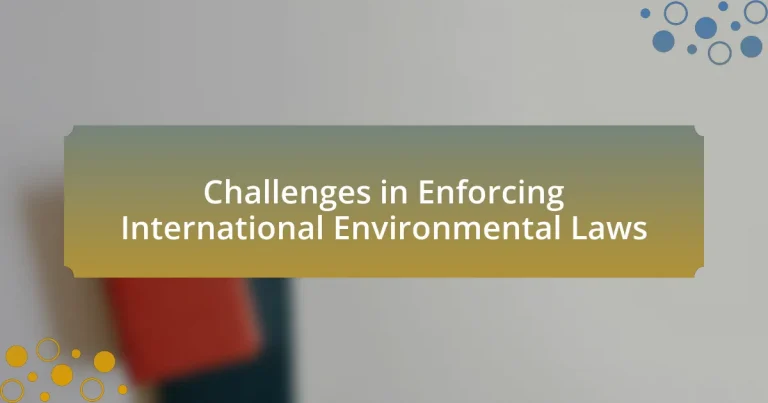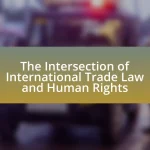The article examines the challenges in enforcing international environmental laws, highlighting key issues such as lack of compliance, insufficient funding, and conflicting national interests. It discusses how economic priorities and political agendas influence adherence to these laws, leading to inconsistent enforcement and gaps in legal frameworks. The article also addresses the complexities of environmental issues, the role of international organizations, and the importance of cooperation and technological advancements in improving enforcement mechanisms. Additionally, it outlines the consequences of ineffective enforcement, including ecological degradation and socio-economic impacts, while suggesting best practices for enhancing compliance and public awareness.
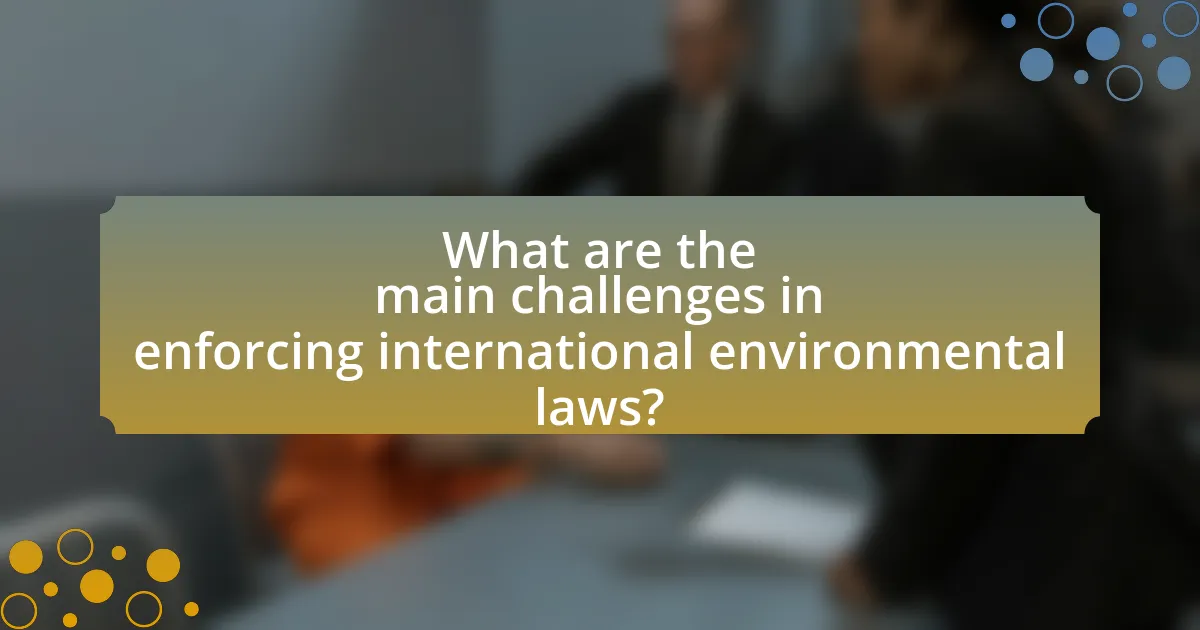
What are the main challenges in enforcing international environmental laws?
The main challenges in enforcing international environmental laws include lack of compliance, insufficient funding, and varying national interests. Lack of compliance arises because many countries prioritize economic growth over environmental protection, leading to inadequate implementation of laws. Insufficient funding hampers the ability of international bodies to monitor and enforce regulations effectively, as seen in the limited resources allocated to organizations like the United Nations Environment Programme. Additionally, varying national interests create conflicts, as countries may resist regulations that they perceive as detrimental to their economic or political goals, undermining collective efforts to address global environmental issues.
How do differing national interests impact enforcement?
Differing national interests significantly impact the enforcement of international environmental laws by creating disparities in commitment and compliance among countries. When nations prioritize their economic or political agendas over environmental regulations, enforcement becomes inconsistent and often ineffective. For instance, countries rich in natural resources may resist stringent environmental laws that could hinder their economic growth, leading to selective enforcement or outright non-compliance. This phenomenon is evident in the Paris Agreement, where nations have varying levels of ambition based on their economic interests, resulting in challenges in achieving collective environmental goals.
What role do economic priorities play in environmental law enforcement?
Economic priorities significantly influence environmental law enforcement by often prioritizing short-term financial gains over long-term ecological sustainability. This dynamic can lead to lax enforcement of environmental regulations, as governments and corporations may prioritize economic growth, job creation, and resource extraction over environmental protection. For instance, in many developing countries, economic development initiatives frequently result in the weakening of environmental laws to attract foreign investment, which can undermine conservation efforts. Studies have shown that regions with strong economic incentives for industries often experience higher rates of environmental degradation, indicating a direct correlation between economic priorities and the effectiveness of environmental law enforcement.
How do political agendas influence compliance with international laws?
Political agendas significantly influence compliance with international laws by prioritizing national interests over global commitments. Governments often align their legal obligations with domestic policies, leading to selective adherence to international agreements. For instance, countries may ignore environmental treaties if they conflict with economic goals, as seen in the withdrawal of the United States from the Paris Agreement under a specific administration, which was driven by a focus on fossil fuel industries. This behavior demonstrates how political leadership can shape the interpretation and enforcement of international laws, ultimately undermining global cooperation and compliance.
What are the limitations of international legal frameworks?
International legal frameworks face several limitations, primarily due to issues of enforcement, jurisdiction, and compliance. Enforcement is often weak because international law lacks a centralized authority to impose penalties, leading to reliance on states to self-regulate. Jurisdictional challenges arise when states are unwilling to submit to international legal processes, as seen in cases where nations refuse to recognize the authority of international courts. Compliance is further complicated by varying national interests and priorities, which can result in selective adherence to international agreements. For example, the Paris Agreement on climate change relies on voluntary commitments from countries, making it difficult to hold non-compliant states accountable. These limitations hinder the effectiveness of international legal frameworks in addressing global environmental challenges.
How do gaps in treaties affect enforcement efforts?
Gaps in treaties significantly hinder enforcement efforts by creating ambiguities and inconsistencies in legal obligations. These gaps can lead to varying interpretations of treaty provisions among signatory states, resulting in a lack of uniformity in compliance and enforcement actions. For instance, the absence of specific targets or timelines in environmental treaties can allow countries to evade accountability, as seen in the Kyoto Protocol, where non-binding commitments led to limited progress in reducing greenhouse gas emissions. Consequently, the effectiveness of international environmental laws is compromised, as enforcement mechanisms struggle to address the disparities created by these gaps.
What challenges arise from the lack of binding authority?
The lack of binding authority in international environmental laws leads to significant challenges in enforcement and compliance. Without binding authority, countries may prioritize national interests over international obligations, resulting in inconsistent application of environmental standards. For instance, the absence of enforceable penalties for non-compliance can encourage states to disregard commitments, as seen in the failure to meet emissions targets under non-binding agreements like the Kyoto Protocol. This lack of accountability undermines collective efforts to address global environmental issues, such as climate change and biodiversity loss, ultimately hindering progress toward sustainable development goals.
How does the complexity of environmental issues hinder enforcement?
The complexity of environmental issues hinders enforcement by creating challenges in understanding, monitoring, and regulating diverse ecological systems. This complexity arises from the interconnectivity of environmental factors, such as climate change, biodiversity loss, and pollution, which often require specialized knowledge and interdisciplinary approaches for effective management. For instance, the intricate relationships between species and their habitats can complicate the identification of violations and the implementation of appropriate legal measures. Additionally, the variability in environmental laws across jurisdictions can lead to inconsistencies in enforcement, as seen in the case of transboundary pollution, where differing regulations can impede coordinated action. These factors collectively contribute to difficulties in holding violators accountable and achieving compliance with international environmental agreements.
What specific environmental issues are most difficult to regulate internationally?
Climate change, biodiversity loss, and ocean pollution are specific environmental issues that are most difficult to regulate internationally. Climate change presents challenges due to the varying commitments and capabilities of countries, as evidenced by the differing targets set in the Paris Agreement. Biodiversity loss is complicated by the lack of a unified framework for conservation, with the Convention on Biological Diversity highlighting the difficulties in enforcing protection across national borders. Ocean pollution, particularly from plastics, is exacerbated by the transboundary nature of marine debris, making it hard to hold specific nations accountable for pollution originating from their territories. These issues require coordinated global efforts, yet political, economic, and social factors often hinder effective international regulation.
How does scientific uncertainty affect policy implementation?
Scientific uncertainty significantly hinders policy implementation by creating ambiguity in decision-making processes. When scientific data is inconclusive or contested, policymakers struggle to establish clear guidelines and regulations, leading to delays or ineffective measures. For instance, the Intergovernmental Panel on Climate Change (IPCC) reports highlight uncertainties in climate models, which can result in varied interpretations of necessary actions, ultimately affecting international agreements like the Paris Accord. This uncertainty can lead to a lack of consensus among nations, complicating collaborative efforts to address environmental issues effectively.
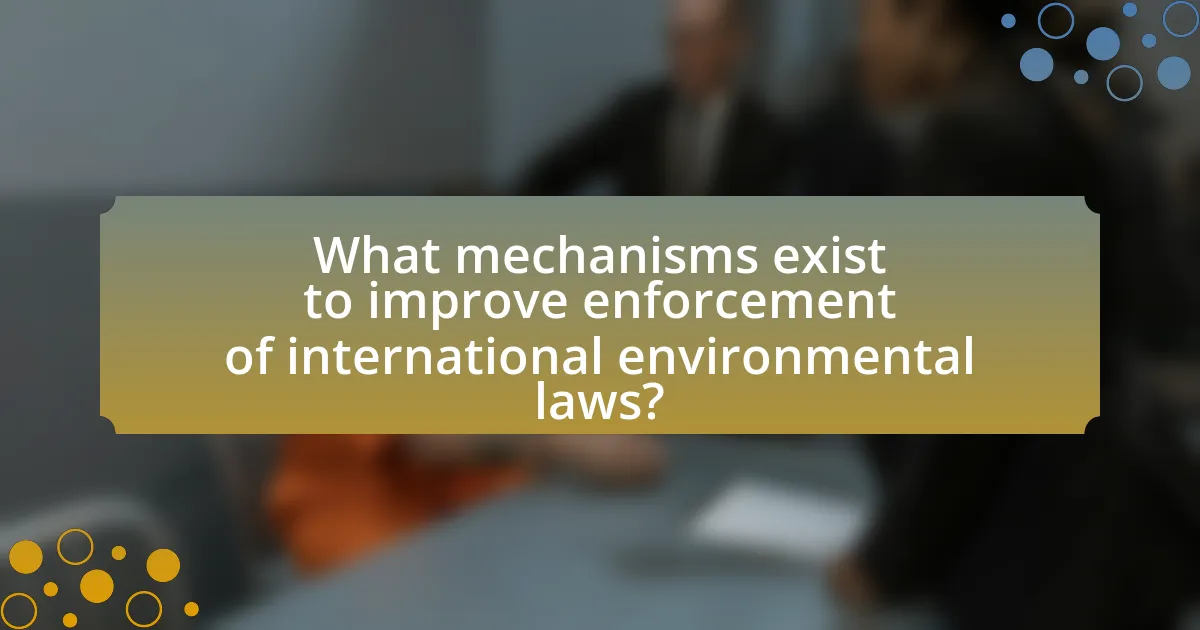
What mechanisms exist to improve enforcement of international environmental laws?
Mechanisms to improve enforcement of international environmental laws include the establishment of binding treaties, the creation of international courts, and the implementation of compliance monitoring systems. Binding treaties, such as the Paris Agreement, compel nations to adhere to specific environmental standards, while international courts, like the International Court of Justice, provide a legal framework for resolving disputes related to environmental violations. Compliance monitoring systems, such as the Global Environment Facility, track progress and hold countries accountable for their commitments, thereby enhancing transparency and encouraging adherence to environmental laws. These mechanisms collectively strengthen the enforcement of international environmental regulations by providing legal recourse, fostering cooperation among nations, and ensuring accountability.
How can international cooperation enhance enforcement efforts?
International cooperation enhances enforcement efforts by facilitating information sharing, resource allocation, and coordinated actions among countries. When nations collaborate, they can share intelligence on environmental violations, which leads to more effective monitoring and enforcement. For instance, the 2016 Paris Agreement exemplifies how countries can unite to address climate change, allowing for collective accountability and shared best practices. Additionally, joint task forces can be established to tackle transboundary environmental crimes, such as illegal logging or pollution, thereby increasing the likelihood of successful interventions. This collaborative approach not only strengthens legal frameworks but also fosters a sense of global responsibility, making enforcement more robust and effective.
What role do international organizations play in facilitating compliance?
International organizations play a crucial role in facilitating compliance with international environmental laws by providing frameworks, resources, and mechanisms for cooperation among nations. They establish guidelines and standards that member states are encouraged to adopt, such as the United Nations Framework Convention on Climate Change, which sets binding targets for greenhouse gas emissions. Additionally, these organizations often offer technical assistance, capacity-building programs, and financial support to help countries meet their obligations. For instance, the Global Environment Facility has funded over 4,500 projects in 170 countries, demonstrating its commitment to enhancing compliance through practical support. Furthermore, international organizations monitor compliance through reporting mechanisms and assessments, which promote transparency and accountability among nations.
How can collaborative agreements strengthen enforcement mechanisms?
Collaborative agreements can strengthen enforcement mechanisms by fostering cooperation among stakeholders, which enhances compliance and monitoring efforts. When multiple parties, such as governments, NGOs, and private sectors, come together under a collaborative framework, they can share resources, expertise, and information, leading to more effective enforcement of environmental laws. For instance, the 2015 Paris Agreement exemplifies how international collaboration can mobilize countries to commit to specific targets, thereby increasing accountability and transparency in enforcement. This collective approach not only amplifies the reach of enforcement actions but also builds trust among parties, making it easier to address violations and implement corrective measures.
What technological advancements can aid in enforcement?
Technological advancements that can aid in enforcement include satellite monitoring, drone surveillance, and blockchain technology. Satellite monitoring provides real-time data on environmental changes, enabling authorities to detect illegal activities such as deforestation or pollution. For instance, the European Space Agency’s Copernicus program offers high-resolution imagery that can track land use changes effectively. Drone surveillance enhances on-ground monitoring by allowing for quick assessments of remote areas, which is crucial for enforcing regulations in hard-to-reach locations. Additionally, blockchain technology can improve transparency and traceability in supply chains, making it easier to hold companies accountable for environmental compliance. A study by the World Economic Forum highlights that these technologies can significantly enhance the effectiveness of enforcement mechanisms in international environmental law.
How can satellite monitoring improve compliance tracking?
Satellite monitoring can significantly improve compliance tracking by providing real-time, accurate data on environmental conditions and activities. This technology enables authorities to detect illegal activities, such as deforestation or pollution, by capturing high-resolution images and data that can be analyzed for compliance with environmental regulations. For instance, a study by the European Space Agency demonstrated that satellite imagery could identify illegal logging in protected areas, allowing for timely interventions. Additionally, satellite data can be integrated with geographic information systems (GIS) to enhance the monitoring of compliance over large and remote areas, ensuring that regulations are enforced effectively and transparently.
What role does data sharing play in enhancing enforcement capabilities?
Data sharing significantly enhances enforcement capabilities by facilitating real-time access to critical information among enforcement agencies. This collaborative approach allows for improved monitoring of compliance with international environmental laws, as agencies can quickly share data on violations, track environmental changes, and coordinate responses. For instance, the Global Fishing Watch initiative utilizes satellite data to monitor illegal fishing activities, demonstrating how shared data can lead to more effective enforcement actions. By leveraging technology and data analytics, enforcement agencies can identify patterns of non-compliance and allocate resources more efficiently, ultimately strengthening their ability to uphold environmental regulations.
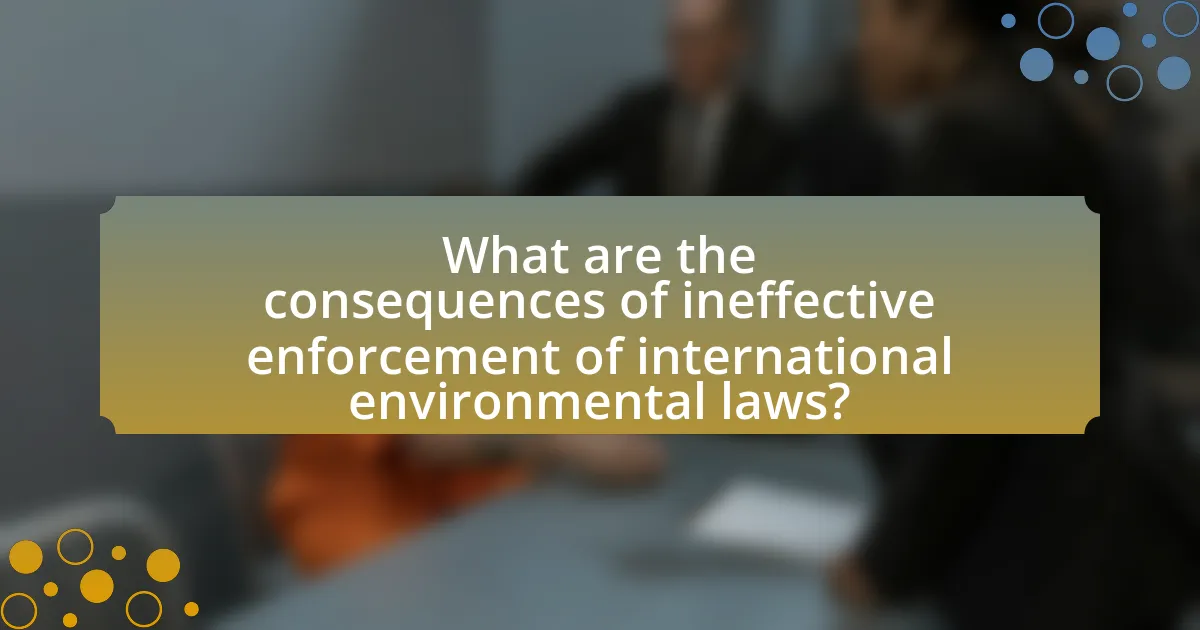
What are the consequences of ineffective enforcement of international environmental laws?
Ineffective enforcement of international environmental laws leads to significant ecological degradation, including loss of biodiversity and increased pollution levels. For instance, the failure to enforce the Convention on Biological Diversity has resulted in the extinction of numerous species, with the World Wildlife Fund reporting that global wildlife populations have declined by an average of 68% since 1970. Additionally, ineffective enforcement allows for unchecked industrial activities that contribute to climate change, as evidenced by the Intergovernmental Panel on Climate Change indicating that greenhouse gas emissions continue to rise due to inadequate regulatory measures. This lack of enforcement undermines global efforts to achieve sustainable development and protect natural resources for future generations.
How does non-compliance affect global environmental health?
Non-compliance significantly undermines global environmental health by allowing harmful practices to persist unchecked. When countries or corporations fail to adhere to international environmental agreements, it leads to increased pollution, biodiversity loss, and climate change, which collectively threaten ecosystems and human health. For instance, the World Health Organization estimates that environmental factors contribute to approximately 13 million deaths annually, highlighting the direct impact of non-compliance on public health. Furthermore, non-compliance can result in the degradation of natural resources, exacerbating issues such as water scarcity and food insecurity, which further compromise global health outcomes.
What are the long-term impacts on biodiversity and ecosystems?
Long-term impacts on biodiversity and ecosystems include species extinction, habitat loss, and decreased ecosystem resilience. These effects arise from factors such as climate change, pollution, and deforestation, which disrupt ecological balance. For instance, the World Wildlife Fund reported that global wildlife populations have declined by an average of 68% since 1970, indicating severe biodiversity loss. Additionally, the Intergovernmental Science-Policy Platform on Biodiversity and Ecosystem Services highlights that habitat destruction can lead to the collapse of ecosystems, affecting services like pollination and water purification. These changes threaten food security and human health, demonstrating the critical importance of biodiversity for sustaining life on Earth.
How does ineffective enforcement contribute to climate change?
Ineffective enforcement contributes to climate change by allowing violations of environmental regulations to persist, leading to increased greenhouse gas emissions. For instance, when countries fail to implement or uphold international agreements like the Paris Agreement, industries may continue practices that harm the environment, such as excessive fossil fuel extraction and deforestation. A study by the Global Carbon Project indicates that global carbon emissions reached a record high in 2021, partly due to lax enforcement of existing laws. This lack of accountability undermines efforts to mitigate climate change, as it enables ongoing environmental degradation and hinders progress toward sustainability goals.
What are the socio-economic implications of failing to enforce these laws?
Failing to enforce international environmental laws leads to significant socio-economic implications, including increased public health risks and economic instability. For instance, non-enforcement can result in heightened pollution levels, which directly contribute to respiratory diseases and other health issues, burdening healthcare systems and reducing workforce productivity. Additionally, the degradation of natural resources, such as water and air quality, can diminish agricultural yields and fisheries, threatening food security and livelihoods, particularly in vulnerable communities. According to the World Health Organization, air pollution alone is responsible for approximately 7 million premature deaths annually, highlighting the urgent need for effective law enforcement to mitigate these health impacts and their associated economic costs.
How does non-compliance impact vulnerable communities?
Non-compliance with international environmental laws severely impacts vulnerable communities by exacerbating their exposure to environmental hazards and undermining their socio-economic stability. For instance, when corporations or governments fail to adhere to regulations aimed at protecting natural resources, vulnerable populations often face increased pollution, loss of biodiversity, and depletion of essential resources like clean water and arable land. According to a report by the United Nations Environment Programme, communities in developing regions are disproportionately affected by environmental degradation, leading to heightened health risks and economic challenges. This non-compliance not only threatens their immediate well-being but also hinders long-term development and resilience against climate change.
What economic costs arise from environmental degradation?
Economic costs arising from environmental degradation include loss of biodiversity, decreased agricultural productivity, increased health care costs, and damage to infrastructure. For instance, the World Bank estimates that environmental degradation can lead to a loss of up to 10% of a country’s GDP due to factors such as soil erosion and water scarcity, which directly impact agricultural yields. Additionally, air and water pollution contribute to significant health care expenses, with the World Health Organization reporting that pollution-related diseases cost economies billions annually. Furthermore, natural disasters exacerbated by environmental degradation, such as floods and hurricanes, can result in extensive damage to infrastructure, requiring costly repairs and recovery efforts.
What best practices can enhance the enforcement of international environmental laws?
Strengthening collaboration among nations is a best practice that can enhance the enforcement of international environmental laws. Effective enforcement requires countries to share resources, information, and best practices, which can lead to more coordinated actions against environmental violations. For instance, the 2015 Paris Agreement emphasizes the importance of international cooperation in addressing climate change, showcasing how collective efforts can lead to improved compliance and enforcement mechanisms. Additionally, establishing clear accountability measures and penalties for non-compliance can deter violations and encourage adherence to environmental laws. Research indicates that countries with stringent enforcement mechanisms, such as the European Union’s environmental regulations, experience better compliance rates, demonstrating the effectiveness of robust legal frameworks in promoting environmental protection.
How can countries improve their legal frameworks for better compliance?
Countries can improve their legal frameworks for better compliance by harmonizing national laws with international standards and enhancing enforcement mechanisms. This alignment ensures that domestic regulations reflect global environmental agreements, such as the Paris Agreement, which sets binding commitments for greenhouse gas reductions. Additionally, countries can establish clear penalties for non-compliance and invest in training for law enforcement agencies to effectively implement these laws. For instance, the European Union’s Water Framework Directive has successfully improved compliance by mandating member states to develop river basin management plans, demonstrating that structured legal frameworks lead to better environmental outcomes.
What role does public awareness play in supporting enforcement efforts?
Public awareness significantly enhances enforcement efforts by fostering community engagement and compliance with environmental laws. When the public is informed about environmental issues and the importance of regulations, they are more likely to support enforcement actions and report violations. For instance, studies have shown that increased public knowledge correlates with higher rates of compliance and reporting of illegal activities, such as poaching or pollution. This collective vigilance not only aids enforcement agencies but also creates a culture of accountability, making it more challenging for violators to operate without scrutiny.
